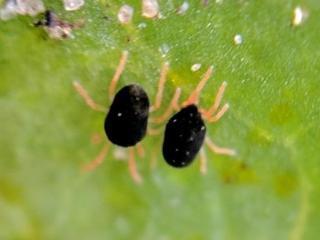Redlegged earth mites are hatching and resistance testing is available this season
- South Stirling
- Borden
Redlegged earth mites (RLEM) have started hatching at South Stirling and Borden recently.
Growers are urged to keep observe for RLEM activity in their pastures and be wary of insecticide resistant RLEM populations.
Redlegged earth mite resistance
Resistant RLEM populations are likely to be present in paddocks that have a history of repeated insecticide applications.
Repeated use of the same insecticide groups, within seasons and between seasons, selects for RLEM to develop resistance.
Growers and consultants are urged to apply integrated pest management (IPM) strategies when managing RLEM due to cases of insecticide resistance in WA. These strategies include; identifying mites, rotating different chemical groups and reserving co-formulations or chemical mixtures only for situations where damaging levels of RLEM and other insect pests are present.
Consider applying insecticides that are pest specific when spraying for pests other than RLEM.
For more information see DPIRD’s Prevent redlegged earth mite resistance page and GRDC’s Resistance management strategy for the redlegged earth mite in Australian grains and pastures fact sheet.
Redlegged earth mite resistance testing in 2022
DPIRD, with co-investment from GRDC, will be undertaking RLEM resistance testing this year. If you notice RLEM surviving applications of insecticides please contact DPIRD technical officer Alan Lord or DPIRD research scientist Svetlana Micic to discuss and arrange for paddocks to be tested.
Correct identification of mites is important
It is easy to confuse mites so growers and consultants are urged to correctly confirm the identity of mites before making management decisions.
RLEM adults are 1mm long with a black body and eight red-orange legs. RLEM have a cold temperature requirement (generally seven days below 20°C average daytime temperatures) before the eggs are triggered to hatch. Immature nymphal RLEM are often a more reddish colour than when they are mature. RLEMs do co-exist with blue oat mites so be careful not to incorrectly diagnose the two mites. For more information refer to the DPIRD Diagnosing redlegged earth mite page.
Identifications can be made by using the DPIRD MyPestGuide Crops app which includes images and information of mite pests.
Alternatively, you can send images for confirmation through the PestFax Reporter app.
For registered insecticide recommendations for mites refer to DPIRD’s 2022 Autumn/Winter Insecticide Guide.
For more mite information contact Research scientist Svetlana Micic, Albany on +61 (0)8 9892 8591 or Technical officer Alan Lord, South Perth on +61 (0)8 9368 3758.
Article authors: Cindy Webster (DPIRD Narrogin) and Svetlana Micic (DPIRD Albany).

